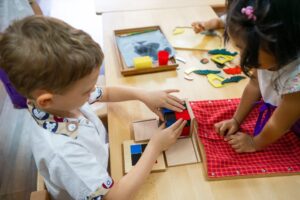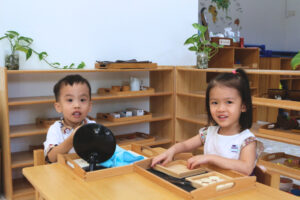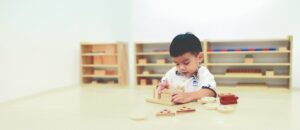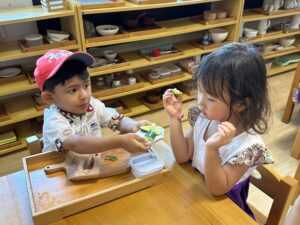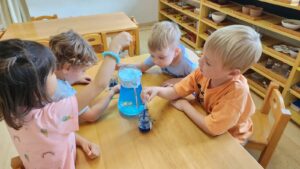Matilda was getting ready to go home, and excitedly reached out to her shoes from the cubby hole. Placing the shoes gently on the floor, she sat down to get ready to put on her shoes. Ms. Honey watched and observed to see if Matilda needed any help. (One of the key tools of a Montessori teacher is to have keen observation of each child as a unique individual and only step in to help if the child needs it.)
Ms. Honey saw Matilda had placed her left foot in the ‘wrong side’ shoe. Ms. Honey held back her attempt to help her to switch sides, as she saw how Matilda was following the steps she had been shown before about how to put on her shoes well.
The steps were:
– Lifting up the tongue of the shoe
– Slip one foot in
– Thumb on heel of shoe
– Push
– She even successfully strapped down her shoe
This was done by Matilda with intense concentration.
Matilda went on to put on the other side of her shoe, right foot in the left side of the shoe, with the same focus and detail to ensure that she was following through all the steps.
There was a moment of immense pride as Matilda finally strapped down the last strap of the shoe. She stood up, and with a great big smile, she looked down at her feet with shoes that she had successfully put on all by herself!
Ms. Honey was equally proud of the attempt of Matilda . She held onto Matilda ’s hands and walked her to the door where Matilda ’s mum was waiting for her. Ms. Honey saw the frown and look of disapproval on Matilda’s mum’s face when her eyes saw Matilda ’s shoes and looked up at Ms. Honey. Ms. Honey quickly gave a quick nod to her and smiled widely, saying “Matilda ’s mum, look at how Matilda put on the shoes all by herself! It was done with such detail and she even managed to strap down both sides of the shoes.”
Matilda ’s mum responded with a smile! Through trust and connection between child, family, and school, we have created a safe and supportive environment where children can thrive independently.
*Please note that names have been changed for privacy
At House on the Hill, our teachers are specially trained to observe each child’s attempts at different tasks. As Dr Maria Montessori said, “Help me to do it by myself”. In that spirit, we offer our support to children at the appropriate moment in order to not cause a hindrance to their development. It is through struggles and challenges that children learn to overcome difficulties and learn through the process. We provide encouragement to the children and break down the tasks for them into small achievable steps. We respect the child’s autonomy and allow them to learn from their mistakes. In our school, we place more importance on the learning process and the journey of discovery, instead of focusing on the outcome.
This allows them to complete the task on their own, and experience the joy of success!
Instead of “correcting” the child’s mistakes, we offer guidance and not correction. Teachers will describe what they see, and ask open-ended questions for the child to think and problem-solve. For example, “I can see your toes look very squashed on this end of the shoes. Why do you think this is so? Shall we try to make them more comfortable?” This helps to redirect them, allowing them to figure out how to correct the steps and empowering them to be more self-reliant, promoting self-confidence.
This approach of self-directed learning allows the children to become more engaged in a task, to develop deeper concentration for longer periods of time, with a love and respect for their own learning and work. As teachers curate each child’s individual development plan according to their learning pace, we ensure each child learns life-long skills and values, helping them to grow into confident young people for the future.

